Installation of underfloor heating indoors has become very popular today. One of the options is a warm water floor. There is a huge range of equipment for its installation on the building materials market. And do right choice it can be very difficult. Therefore, it is necessary to study the characteristics of each element, and figure out whether there is a need for such a structure as a water floor at all.
Underfloor heating is one of the most cost effective and popular types of heating systems. The room is heated by circulating hot water through a pipeline built into the floor.
a is a layered structureconsisting of:
- base layer (wood floor or concrete slab);
- waterproofing;
- thermal insulation (prevents heat from escaping from a given direction);
- water floordirectly heating the room;
- concrete screed;
- final cover.
How to choose equipment
The main elements of this heating system are pipes and boiler. In addition, you may need a manifold and a box for it, a pump, fittings connecting pipes to the boiler, heat and waterproofing materials.
Pipes
Among can be used pipes made of different materials:
- of stainless steel;
- copper;
- reinforced polyethylene;
- metal-plastic etc.
Today they produce pipes specially designed for heated floors. They are very flexible and can withstand high pressure. Their service life can reach 25-28 years.... But they are quite expensive. The best option is metal-plastic pipes. They can last a long time and are easy to install. Better to give up polypropylene pipesas they are not suitable for installation in concrete screed... If you take metallized ones, then preferably with an antioxidant coating.
A separate pipe of suitable length must be taken for each heating circuit. There should be no connections in the middle of the system. The optimum tube diameter is 2 cm.
How to replace the central heating system with a warm floor:
Collector
Collectors come in different types... The simplest models only let the coolant through the pipes, and no longer provide other functions. More modern designs make it possible to regulate the water supply to each separate branch of the system, to set its temperature. The newest options are equipped with an auto-adjustment system that automatically sets the desired parameters.
To choose a collector, one should be guided by the number of circuits in the house (apartment), and the need for their constant control. If all rooms should have the same temperature level, you can get by with a simple collector model, and not overpay for additional functions.
Thermal insulation
Before installing the pipes, thermal insulation should be done. You cannot do without heat loss during the operation of a warm floor. The system will give off some of the heat to the outside. Therefore, heat-insulating elements are placed under the tubes. This will keep warm, speed up the process of warming up the room.
To choose a material for heat insulation, should be considered:
- heat output of the heating system;
- bearing capacity of the floor;
- profitability.
Insulation materials:
- penofol;
- expanded polystyrene;
- corkwood;
- mineral wool.
For a device in a warm water floor, expanded polystyrene is better. A layer of it is made at least 3 cm. To prevent heat from escaping at the joints, they are reinforced with a polymer cloth with a reinforcing mesh. Since expanded polystyrene is a highly flammable substance, it is additionally covered with a foil composition.
For a complete overview of equipment for warm water floors, see here:
Installation options
There are several methods for laying pipes for a water floor:
- Snake - pipes are laid along the wall, at the end they are bent and directed to the other side. This covers the entire floor surface. The difficulty of this installation method is in the design of the tube bend. With a small pitch, the pipe is very difficult to bend, and the large distance between the pipes does not properly warm the surface.
- Double snake - unlike the previous method, 2 pipes are used here, running parallel to each other. The distance between them should not be more than 3 cm.
- Spiral (snail) - styling occurs from the outer perimeter of the room, moving towards the center. From the center, the pipe is turned back, closing the chain. This installation scheme is very popular, because due to the alternation of hot and cooled tubes, uniform heating is ensured over the entire surface.
- Combined method - several options for installing pipes are used in one room. This is true if the room has a non-standard shape with protrusions or recesses, for example, for installation.
Mounting
Before producing, you need to prepare the surface. It should be perfectly flat. For this, you can use self-leveling potting mixes.
- Lays down on the rough surface waterproofing material ... At the joints, it is attached with tape. Along the perimeter of the walls, it is fixed with a damper tape.
- The next layer is thermal insulation... The thickness of the material depends on the characteristics of the room. For example, in a basement or on the ground floor, the insulation density must be high. This helps reduce heat loss. For the kitchen, a layer of ordinary foil will be enough.
- Next stage - pipe laying according to the chosen scheme... The average distance between them should be about 30 cm. They are attached with plastic clamps to the reinforcing mesh, or with special profiles. Insulation materials are produced with already provided projections, with the help of which pipes are fixed.
- Fittings connect the tubes to the manifold.
- The collector is connected to the system and run it in test mode. The pressure and temperature should be raised gradually over at least 4 hours. In the absence of leaks, the maximum allowable pressure is tested by supplying water to the system using a pump.
- After testing the structure, the pipes are covered with a reinforcing mesh. and pour cement screed not thinner than 3 cm allows laying tiles directly on the screed.
- After the screed has dried, lay... The moisture content of the surface should be 2–4%.
Read how to put linoleum in your kitchen.
Video tutorial on installing a warm water floor:
Errors in the installation of a warm floor, do not allow them:
The installation of a warm water floor should be approached responsibly. The performance of the system depends on the quality of the equipment and installation, so choose a duct manufacturer, for example. To be sure of the operation of the warm floor, it is better to entrust its installation and connection of the system to the collector to professionals.
It is not worth saying that warm floors are a technological novelty today. Humanity has known warm water floors since the days of ancient Rome. But today this technical solution, due to its versatility, is not a very simple task. And it is difficult to cope with it without special training. Therefore, in this article we will carefully consider this heating system, its advantages, disadvantages. We will also determine what equipment is needed for installing warm floors, laying technology, and so on.
Advantages of warm water floors
- When heating large and small areas, significant (up to 12%) savings on heat energy compared to a radiator heating system.
- Creation of a comfortable thermal regime for a person: temperature at head level - 200C, at leg level - 22-240C.
- The small difference between the air temperature and the floor provides a low speed of convective currents, as a result - no dust in the air. (See also: )
- The possibility of uniform heating of the room without cold and overheated zones.
- Maintaining optimal humidity and air temperature, preventing dampness and ensuring the creation of comfortable conditions for human well-being.
- If the circulation of the coolant is turned off, the warm floor can accumulate heat and maintain optimal air parameters for several hours.
- The service life of polymer pipes used in the warm water floor system is 50 years. (See also: )
- Equipment for underfloor heating does not require special maintenance during operation.
- Lack of electromagnetic fields.
- When designing the interior, the premises do not cause design problems.
Disadvantages of warm water floors
- The most expensive underfloor heating project in comparison with options for heating with infrared film or heat cable.
- In the event of damage to one section or section of the pipeline, it entails shutdown and costly repair of the entire system. (See also: )
- Labor intensity of installation and its considerable period.
- Low heat load per unit area compared to heating with infrared foil or electric cable.
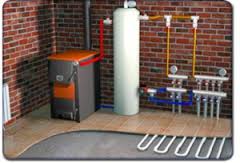
Installation of water floors
There are 3 types of water underfloor heating systems: concrete, floor and wood. The concrete type involves laying a water floor with a concrete screed. It is characterized by a special installation duration - 21 days, due to the concrete hardening period. Besides, general construction (pipes, insulation, screeds, top coat) reduce the height of the room by 10 or more centimeters.
Equipment for a warm water floor consists of a circulation pump, collectors and fittings for connecting to a heating system, fasteners, metal-polymer or polymer pipes, thermal insulation.
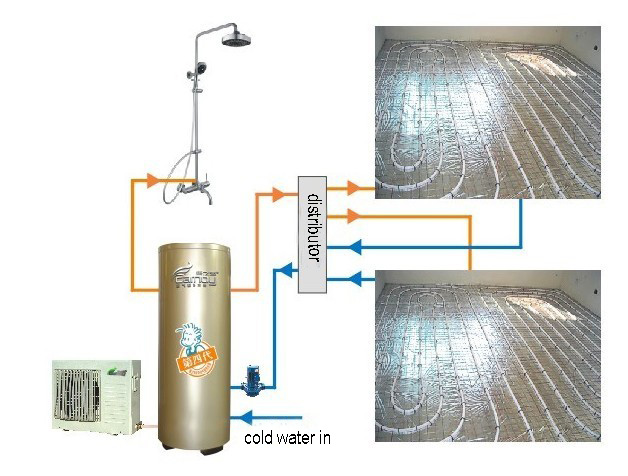
Note. The pipelines are laid according to the two most common patterns: snail (spiral) and zigzag (snake). The first option is the simplest and is distinguished by the speed of installation. The second option is characterized by the ability to provide the most uniform heating and the ability to withstand particularly freezing zones near the window or balcony due to the minimum installation step.
Equipment for water heated floors
Consider the main equipment for water heated floors:
- Pipes and fittings. For a comfortable and long-term operation of the water floor, it is necessary to use only high quality plastic pipes, since they are covered with concrete, and in case of damage, it will be necessary to break open the entire floor. Hence such high requirements. It is not allowed to use pipes for hot and cold water supply for underfloor heating. The quality of the pipes must guarantee one hundred percent tightness, they must be bent by hand, and they protective layer should prevent oxygen diffusion. One of the main requirements for laying a warm water floor is the use of a single piece of pipe. The life of the pipe and the life of the building must be commensurate. As a rule, plastic and metal-plastic pipes with a diameter of 16-20 mm. The distance between them should be in the coil from 100 to 300 mm. It is necessary that they do not corrode, the inner diameter is maintained throughout the entire service life, and deposits do not accumulate on the walls that promote corrosion, which can affect the entire system as a whole, including the heating system boiler.
- Control system and other equipment. For the smooth operation of the entire system of a water heated floor, in addition to pipes and materials, other additional equipment is required:
Thermal insulation of the floor. As thermal insulation, conventional foam and its modifications are used, such as extruded polystyrene, extruded polystyrene foam (polyisol, isopharm, styrodur). To do this, it is best to use a specialized teraplenie, which is a glued foil with markings for laying pipes. The thickness of the insulation layer must be more than 22 mm, for an unpaved floor or unheated premises - more than 30 mm. In order to prevent thermal bridge between the wall and the heating plate, a thin sheet of foam or damper tape is laid.
Collector with flow meters;
Ball valves included;
Servo;
Eurocone connector;
Pump-mixing block;
Collector cabinet.
- The manifold with adjustable flow meters, which distributes the coolant to the circuits, is made of stainless steel. For each heating circuit, one upper meter is integrated in the supply line, which allows precise and convenient adjustment of the water flow without using tools. The volume of water consumed can be seen in the sight glass.
- The ball valve kit includes 2 nickel-plated balls.
- The actuator is used to open / close the heating circuit. It is connected to a temperature controller, which is installed in the heated room.
- The Eurocone connector provides the connection between the underfloor heating system pipe and the collector.
- The pump-mixing unit provides temperature control of the direct line (depending on the outside temperature) by adding water from the return line.
- Manifold cabinet containing the heating circuit distributor, central unit for temperature control of individual rooms.
Warm water floor country house must be provided with an autonomous energy source that heats water. Mainly used for this gas boilers, as the current situation with prices for energy resources in our country makes them especially in demand. Among them it is necessary to single out condensing boilers, which save 35% of the consumption of conventional boilers. This significantly reduces the owner's heating costs, which quickly pay off the high cost of equipping warm water floors.
One of the sources of energy for a warm water floor can be a heat pump. It allows about 75% of the energy for this floor to be obtained from the environment. And this is environmentally appropriate and economically beneficial.

The value of flooring for a water floor
Since the complex engineering device of the water floor system is closed, it seems that it is the finishing flooring provides warmth and comfort. Therefore, the value of the texture and quality of the floor is great importance for the homeowner. A very common water floor covering is ceramic tile, which has good thermal conductivity, does not undergo deformation, is resistant to abrasion and has a perfectly flat surface. It is believed that maximum comfort is provided by tiles with a thickness not exceeding 30 mm.
Today, the domestic market offers a wide range of quality products. And although ceramic tiles are very popular and are used not only in the kitchen and in the bathroom, nevertheless, many owners prefer living rooms see the wood flooring.
Laminate is perfectly combined with a warm water floor, since in terms of its characteristics it is more convenient to install and operate than parquet. But there is one feature regarding the warm floor. When choosing a laminate for it, you must make sure that this brand of laminate meets the requirements of the permissible thermal resistance of the material and does not exceed the value R1 \u003d 0.15 m2 * K / W. This suggests that the floor covering is specifically designed for underfloor heating.
Wood and textile coatings for warm water floors require a special heat-resistant adhesive. For the installation of parquet, you must also comply with the humidity requirements, it should not be less than 4%. Parquet boards and block parquet are very picky about temperature and humidity (due to their tendency to deform when these parameters are violated). Therefore, their use for a warm water floor is a very risky decision.
The use of materials is permitted only if there is an indexed link to the page with the material.
Water heated floors are the way to create comfort and coziness in the room. Their manufacture requires special attention. This is especially true for the selection of the necessary equipment. It must meet modern quality standards, which will ensure good heating of the home. What accessories are required for a warm water floor? You will get the answer to this question in this article.
What you need to buy
To create warm floors, the first step is to make a project. According to this project, all necessary equipment is being assembled. Among the main purchases should be the following components:
- Thermal insulation of various thicknesses.
- Pipes and fittings.
- Damper self-adhesive tape, 5 to 10 mm thick.
- Pipe fasteners: anchor bracket, mounting plate, pipe holders, an arc for turning pipes at right angles, etc.
- Collector cabinet.
- Reinforcing mesh.
- Boiler.
- Screed filling material: sand, cement and plasticizer.
This is perhaps the main equipment that will be required to create floor heating. Now let's take a closer look at some of the categories.
Pipes and fittings

Only high-quality pipes can provide a good heated floor. Today you can buy metal-plastic pipes or cross-linked polyethylene. This material fully complies with quality standards. They can be poured with a cement-sand screed.
Considering the fact that the pipes will be filled with a screed, special attention should be paid to their quality. Otherwise, it will be very difficult to remove them from the floor for repair.
It is forbidden to use pipes that are used for wiring water supply. Quality pipes must meet the following criteria:
- Tightness.
- Flexibility.
- Oxygen diffusion protection.
In order for the laid circuit to serve as long as possible, it should not consist of two or more pieces of pipe.

These requirements apply to all commercial fittings that connect the piping system in the manifold cabinet. In order not to fall for a fake, it is better to purchase all such equipment from trusted suppliers..
Control system equipment
Each warm water floor is equipped with a control system. As a rule, it is located in the manifold. There should be the following equipment:
- Pump-mixing unit. Through it, the temperature is monitored and regulated. The control is carried out in a straight line for adding cold water.
- Collector with flow meters. This equipment evenly distributes the coolant around the circuits. It is desirable that it be made of stainless steel. For the convenience of monitoring the flow rate of the coolant, an individual upper counter is installed. In the existing sight glass, you can observe the water flow.
- Nickel plated ball valves.
- Collector cabinet. It is in this place that the entire control system is located.
- Servo. The actuator closes and opens the heating circuit, which is connected to the temperature controller. The thermostat is installed in a heated room.
- Eurocone connections. They are intended for joining pipes with a manifold.
These accessories for a warm water floor will create a reliable control system.
The key link in the system is the collector!

The main equipment of the entire underfloor heating system is the collector. It can be purchased both ready-made and disassembled. Moreover, some decide to make it homemade. But for this it is important to understand the principle of its operation and choose only high-quality equipment. Additionally, the collectors are equipped with circulation pumps, pressure stabilizers, thermostats and the like. It has a different number of outlets for heating circuits. Each circuit is equipped with shut-off valves... This allows, if necessary, to block a certain heating section.
Thermal insulation material
For a warm floor, an insulating layer is an important requirement. It fits under the pipes. The thickness can be around 50 mm.
There are many types of thermal insulation. For example, foil, expanded polystyrene, mats, waterproofing boards, and the like.
Some people use Styrofoam. But in this case, an additional waterproofing film layer is required. It completely eliminates the appearance of condensation.
All of the equipment listed in this article will allow you to create a complete floor heating system. We hope this material will help you in choosing and assembling the necessary components. We encourage you to leave comments on this article if you need other additional equipment.
Still have questions?
One of the main stages in the development of a warm floor design for a specific room is a competently calculated calculation of the main parameters of the system. Only mathematical formulas and calculations will help to obtain the necessary coefficients, based on which a decision will be made on the direct technical organization underfloor heating and its economic efficiency.
 First, it is necessary to assess the feasibility and effectiveness of using a system with a warm floor in the room. To do this, you need to study all the links in the heating chain - where the first link will be the boiler for the warm floor. I would like to note right away that the operation of the system is extremely ineffective and not cost-effective.
First, it is necessary to assess the feasibility and effectiveness of using a system with a warm floor in the room. To do this, you need to study all the links in the heating chain - where the first link will be the boiler for the warm floor. I would like to note right away that the operation of the system is extremely ineffective and not cost-effective.
 Taking into account the time spent on the initial heating of a seven-centimeter concrete screed to the required temperature, it can be concluded that it will be necessary to stay at the boiler, periodically loading fuel, for several hours, which is practically unacceptable. Conclusion - it is necessary to use a gas boiler for a warm water floor. The exception is automatic pellet boilers, which work well on warm floors.
Taking into account the time spent on the initial heating of a seven-centimeter concrete screed to the required temperature, it can be concluded that it will be necessary to stay at the boiler, periodically loading fuel, for several hours, which is practically unacceptable. Conclusion - it is necessary to use a gas boiler for a warm water floor. The exception is automatic pellet boilers, which work well on warm floors.
If the room where the possibility of installing a warm floor is being considered is not on the first floor, it is imperative to examine the condition of the floors between floors.
 In the case of a poor state of the lag or the lack of the necessary strength of the floors as a whole, the installation of the system in such conditions can be extremely difficult or completely impossible. Here it is necessary to measure the economic component - what will be the price of materials for a warm water floor, taking into account the need to strengthen the partitions.
In the case of a poor state of the lag or the lack of the necessary strength of the floors as a whole, the installation of the system in such conditions can be extremely difficult or completely impossible. Here it is necessary to measure the economic component - what will be the price of materials for a warm water floor, taking into account the need to strengthen the partitions.
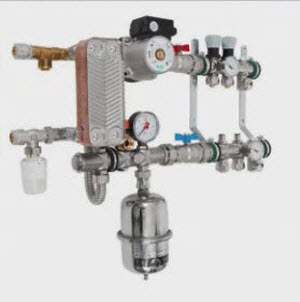 When installing the underfloor heating system in a room located on the ground floor, it is necessary to realistically assess the possibilities of organizing high-quality thermal insulation with a basement. There may be such a situation that the price of a heater for can make up a significant part of the underfloor heating budget. In general, all the materials for underfloor heating that are planned to be used for assembly and installation are best used by well-known brands in order to avoid unpleasant surprises later.
When installing the underfloor heating system in a room located on the ground floor, it is necessary to realistically assess the possibilities of organizing high-quality thermal insulation with a basement. There may be such a situation that the price of a heater for can make up a significant part of the underfloor heating budget. In general, all the materials for underfloor heating that are planned to be used for assembly and installation are best used by well-known brands in order to avoid unpleasant surprises later.
Components of a water underfloor heating system
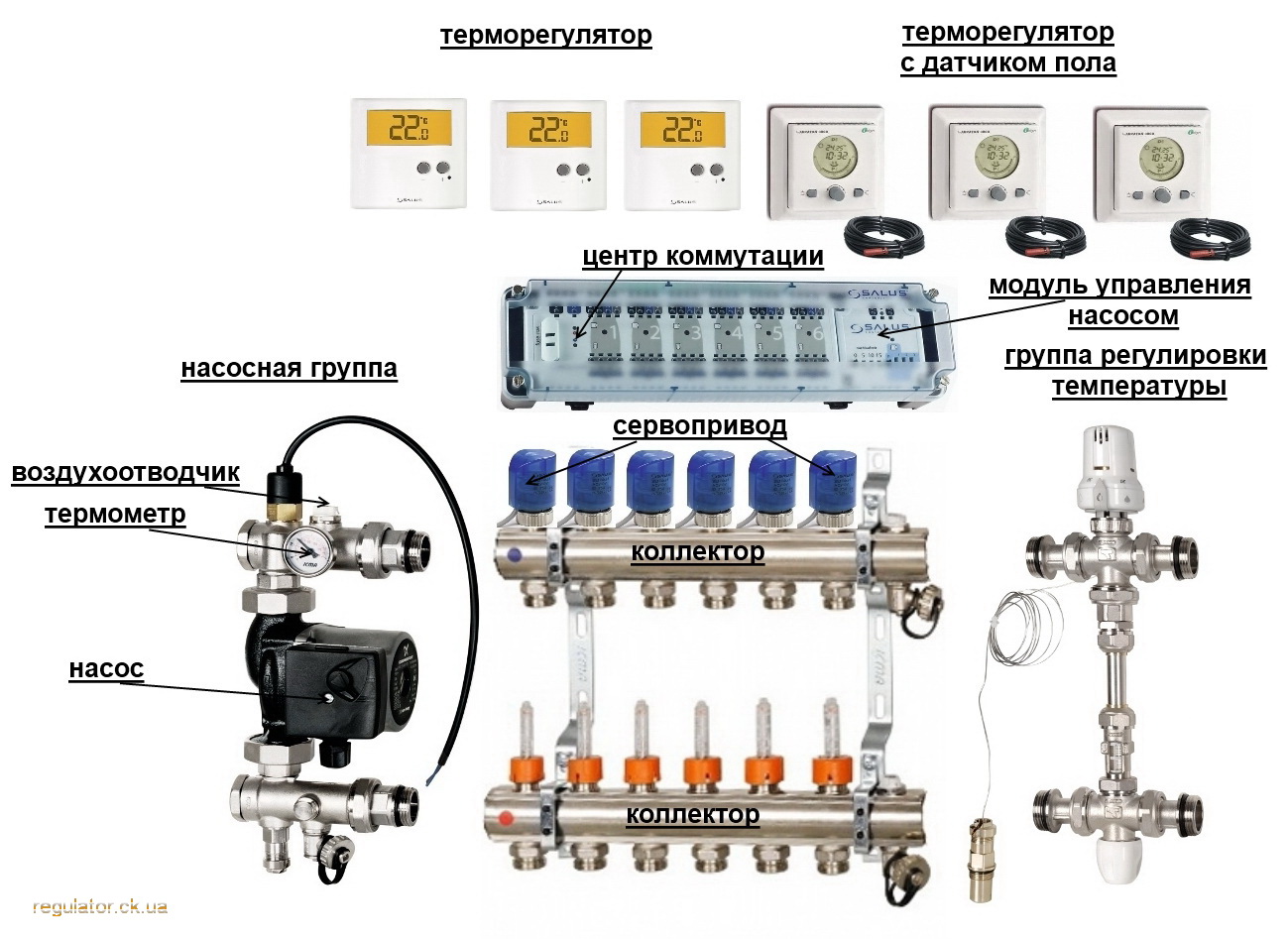 Basically, a standard set of components is used, with some minor differences depending on the specific characteristics of the room and the company that produces the flooring equipment. Provided that an electric or a warm water floor is used to heat the coolant, the set of other components in the general case looks like this:
Basically, a standard set of components is used, with some minor differences depending on the specific characteristics of the room and the company that produces the flooring equipment. Provided that an electric or a warm water floor is used to heat the coolant, the set of other components in the general case looks like this:
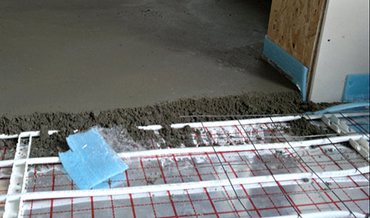 Subsequently, the pipes are poured with a concrete screed so that the screed thickness is at least seven centimeters. It should be noted that after filling with a screed, it will no longer be possible to replace the pipes and in the literal sense, the countdown of their service life will begin. Therefore, it must be remembered that the cost of a pipe for a warm floor is proportional to its quality and durability. This is exactly the case when you don't need to save.
Subsequently, the pipes are poured with a concrete screed so that the screed thickness is at least seven centimeters. It should be noted that after filling with a screed, it will no longer be possible to replace the pipes and in the literal sense, the countdown of their service life will begin. Therefore, it must be remembered that the cost of a pipe for a warm floor is proportional to its quality and durability. This is exactly the case when you don't need to save.
Mixing unit (water mixing unit)
 Analyzing equipment for a warm water floor, I would like to draw attention to the main element that maintains the temperature of the warm floor in a given range. The principle of its operation is quite simple and universal for almost all layout options for a water heated floor.
Analyzing equipment for a warm water floor, I would like to draw attention to the main element that maintains the temperature of the warm floor in a given range. The principle of its operation is quite simple and universal for almost all layout options for a water heated floor.
The mixing unit contains the following components:

Mixing valve
There is a graduated scale on the handle of the thermostatic head of the mixing valve for manual setting of the required temperature in the circuit after mixing. A thermosensitive element is installed in the head itself, pressed by the axis of the adjusting handle, which, in response to heating, changes its geometric dimensions, thereby slightly opening or blocking the "return" flow, which is mixed into the supplied coolant. In some cases, upon reaching the set temperature, the supply of the main heat carrier (from the boiler) is completely closed and the circuit is closed, cyclically pumping the liquid circulating in it until it partially cools.
 Quite often, instead of a mechanical one, a servo drive on a thermal head is used as a control element of the mixing valve. Unfortunately, it will not work without overpaying to buy for a warm floor with a servo drive. Such a technical solution is not always justified due to an increase in the number of piping elements and a significant increase in the cost of the system.
Quite often, instead of a mechanical one, a servo drive on a thermal head is used as a control element of the mixing valve. Unfortunately, it will not work without overpaying to buy for a warm floor with a servo drive. Such a technical solution is not always justified due to an increase in the number of piping elements and a significant increase in the cost of the system.
Together with the servo drive, it becomes necessary to use temperature sensors that take readings from the supply, return and ready-mix.
![]() These indicators are processed by the automation for a water-heated floor with a central controller (brains) of the system, giving out a control voltage to the mixer servo drive system, which regulates the mixing process of heat carriers. Therefore, the price of a three-way valve for underfloor heating depends on the presence of a servo drive in the delivery set - you need to pay attention to this when buying.
These indicators are processed by the automation for a water-heated floor with a central controller (brains) of the system, giving out a control voltage to the mixer servo drive system, which regulates the mixing process of heat carriers. Therefore, the price of a three-way valve for underfloor heating depends on the presence of a servo drive in the delivery set - you need to pay attention to this when buying.
Circulation pump
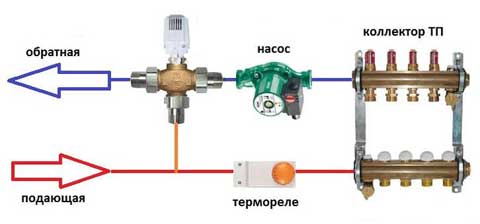 It is necessary to pump the heat carrier inside the underfloor heating circuit at a certain speed, the value of which is set by the control unit included in the pump kit. The pumping speed affects the optimization of heat transfer in the system as a whole: if the circulation rate is too high, the heat from the carrier does not have time to be absorbed by the concrete screed, and if the circulation rate is insufficient, the coolant cools too much, which negatively affects the heating efficiency.
It is necessary to pump the heat carrier inside the underfloor heating circuit at a certain speed, the value of which is set by the control unit included in the pump kit. The pumping speed affects the optimization of heat transfer in the system as a whole: if the circulation rate is too high, the heat from the carrier does not have time to be absorbed by the concrete screed, and if the circulation rate is insufficient, the coolant cools too much, which negatively affects the heating efficiency.
Thermometer
To optimize the process of correct heat transfer, the readings of the thermometers entered into the circuit of the unit are needed. The difference (delta) between the temperature of the fluid entering the floor pipes and the "return" should be no more than 5 degrees. If the delta is greater, we accelerate the circulation of the medium, preventing it from excessively cooling, by switching the speed of the circular pump. The mixing unit also includes several shut-off ball valves.
With proper assembly of the mixing unit, there should be four thermometers:
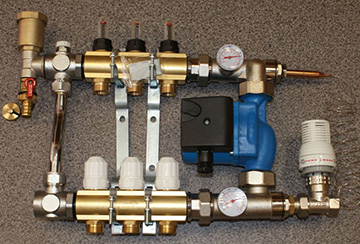
 Saving on unwillingness to install separate valves by installing and connecting the warm floor to the boiler, as a result, can significantly complicate the process of replacing some elements of the system if they break down, or when upgrading the underfloor heating system. The cranes themselves are recommended to be used exclusively reliable from well-known world manufacturers.
Saving on unwillingness to install separate valves by installing and connecting the warm floor to the boiler, as a result, can significantly complicate the process of replacing some elements of the system if they break down, or when upgrading the underfloor heating system. The cranes themselves are recommended to be used exclusively reliable from well-known world manufacturers.
Collector assembly (collector)
 A very important underfloor heating unit, the basis of which is a distributor comb, which is a pipe with the required number of inputs and outputs, according to the number of loops. Directly the comb for the warm floor assembly contains already screwed-on control valves that regulate the flow of the coolant into the loop of the underfloor heating circuit.
A very important underfloor heating unit, the basis of which is a distributor comb, which is a pipe with the required number of inputs and outputs, according to the number of loops. Directly the comb for the warm floor assembly contains already screwed-on control valves that regulate the flow of the coolant into the loop of the underfloor heating circuit.
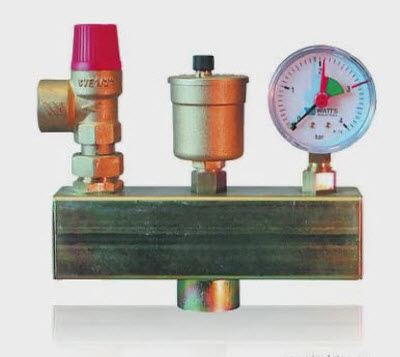 Also, when the issue of buying components for a warm water floor is being decided, it is reasonable to take care of purchasing a safety group, which will be an important element of the collector unit and will save you from serious emergencies. In its composition, this group contains a bypass, a safety (explosive) valve and an air vent to remove excess air from the system. If the pressure is significantly exceeded, the safety valve will open (work) and part of the coolant will drain, protecting the system from explosion or depressurization.
Also, when the issue of buying components for a warm water floor is being decided, it is reasonable to take care of purchasing a safety group, which will be an important element of the collector unit and will save you from serious emergencies. In its composition, this group contains a bypass, a safety (explosive) valve and an air vent to remove excess air from the system. If the pressure is significantly exceeded, the safety valve will open (work) and part of the coolant will drain, protecting the system from explosion or depressurization.
Directly when establishing optimal system performance, the valves on the manifold should be adjusted accordingly with the design balancing table.
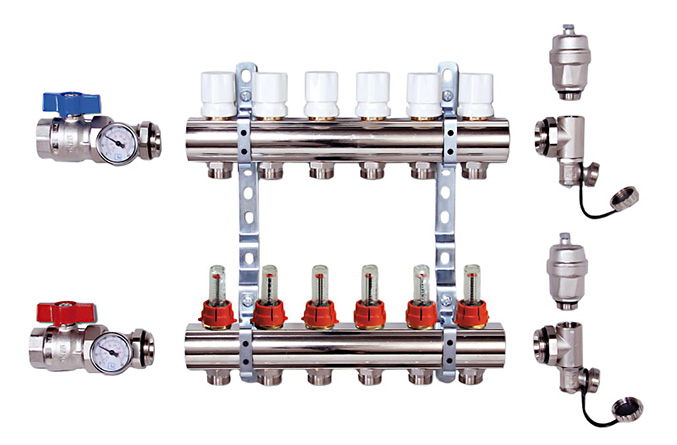 It contains adjusting recommendations indicating how many revolutions from the fully closed state the corresponding control valve should be turned. Such an adjustment is necessary to equalize the pressures and the amount of circulating heat carrier, in accordance with the actual calculated demand of the given room.
It contains adjusting recommendations indicating how many revolutions from the fully closed state the corresponding control valve should be turned. Such an adjustment is necessary to equalize the pressures and the amount of circulating heat carrier, in accordance with the actual calculated demand of the given room.
Features of installation and laying
 The efficiency and safety of the entire system will largely depend on the quality of the subfloor surface preparation. An important role in the durability and reliability of floor elements is assigned to the quality of connecting pipes and hoses. High-quality components have always been not cheap and in this case, for example, the price of a hose for a warm floor is quite significant, and the maximum pipe length for a warm floor can be measured in hundreds of meters, which is quite sensitive for the budget.
The efficiency and safety of the entire system will largely depend on the quality of the subfloor surface preparation. An important role in the durability and reliability of floor elements is assigned to the quality of connecting pipes and hoses. High-quality components have always been not cheap and in this case, for example, the price of a hose for a warm floor is quite significant, and the maximum pipe length for a warm floor can be measured in hundreds of meters, which is quite sensitive for the budget.
It is best to disassemble the main stages of installing a warm floor according to the points:
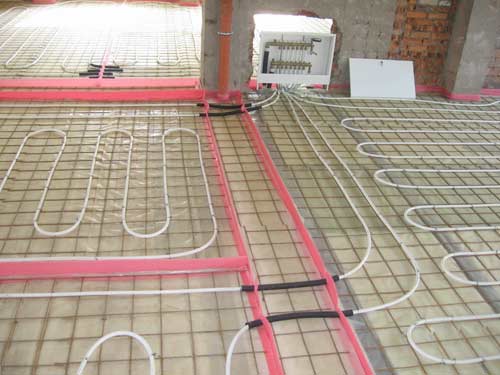
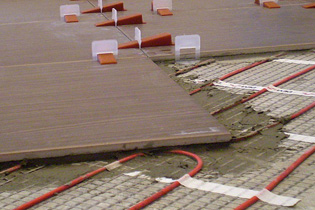 Subsequently, a finishing floor is mounted on the screed, which, ideally, is a ceramic tile or self-leveling floor, and as the worst option in terms of heat transfer and heating efficiency, it is a wooden floor. With the modern development of technology and the presence of certain skills and the appropriate tool, the installation of a water floor can be done independently.
Subsequently, a finishing floor is mounted on the screed, which, ideally, is a ceramic tile or self-leveling floor, and as the worst option in terms of heat transfer and heating efficiency, it is a wooden floor. With the modern development of technology and the presence of certain skills and the appropriate tool, the installation of a water floor can be done independently.
The best heaters for water systems are expanded polystyrene (PS), including extruded (EPS). All other things being equal, they are cheaper than cork and polyurethane foam. Have basalt wool PPP benefits in terms of performance: there is no hygroscopicity and vapor permeability.
A pressure gauge is installed on the feed manifold, which monitors the pressure in the system. A pump is also connected here if it serves only a warm floor.
Pump
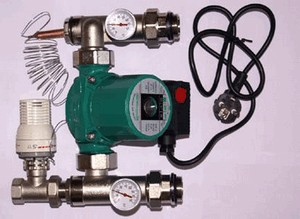 Provides the circulation of the coolant in the system. Powered by electricity. It is recommended to provide an autonomous energy source in the house in case of power outages, because the floor will not function without a pump ().
Provides the circulation of the coolant in the system. Powered by electricity. It is recommended to provide an autonomous energy source in the house in case of power outages, because the floor will not function without a pump ().
Pumps for heating systems are of centrifugal type. In private buildings, units with a wet rotor are used: when the coolant is pushed through the housing, it washes the engine along the way, thereby performing the function of lubrication.
"Wet" pumps have low power, trouble-free and durable in comparison with dry ones.
Temperature control
 The most common way is a faucet with a thermal head. Its structure contains a substance that is sensitive to temperatures: when heated, it expands and blocks the inlet through which hot water enters the circuit. When it cools, it contracts and unlocks the access of the coolant.
The most common way is a faucet with a thermal head. Its structure contains a substance that is sensitive to temperatures: when heated, it expands and blocks the inlet through which hot water enters the circuit. When it cools, it contracts and unlocks the access of the coolant.
Often, the ends of the combs far from the boiler are connected by a bypass and a three-way valve is installed on it, which acts as a mixer: as necessary, it adds a hot coolant to a cold one, after which the liquid again diverges along the circuits.
To automate the process, a servo drive with a thermostat is used. It is connected to air sensors located in the room.
The system reacts not only to the temperature of the water in the circuits, but also to the temperature in the house: when the sensor signals a cold snap, the heating is intensified.
Automatic equipment for the underfloor heating water system allows you to adjust the temperature depending on the season and the weather outside, turn on / off heating by time, etc.
Conclusion
 A few words about the finish coat. Tiles are ideal for warm floors: they are not afraid of water and high temperatures, conducts heat well ().
A few words about the finish coat. Tiles are ideal for warm floors: they are not afraid of water and high temperatures, conducts heat well ().
When using laminate, parquet, linoleum, you should choose modifications suitable for warm floors.
The Warm Wasser marking on the laminate means that the thermal conductivity of this material is maximum for its category, and the thermal stability is high: it will not dry out or swell when heated.
The same applies to other coatings.
Video about the equipment of a warm water floor.



